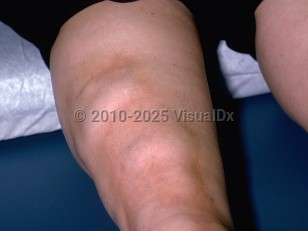Eosinophilic fasciitis in Child
Alerts and Notices
Important News & Links
Synopsis

EF presents with symmetric tenderness, erythema, and edema of affected extremities, with induration of the underlying muscle fascia and subcutaneous tissue occurring over days to weeks. The skin becomes tethered, giving rise to a characteristic dimpling and peau d'orange appearance. Elevation of the affected limb will cause a depression along superficial veins, leading to distinctive furrowing referred to as the groove sign. Constitutional symptoms, such as fatigue and weight loss, and local hypopigmentation, hair loss, and scaling may be seen. Secondary arthritis, joint contractures, and nerve compression may occur. Arthritis is less commonly seen among children than adults.
The disease is typically symmetric and preferentially affects the extremities, especially the forearms and calves. The face is generally spared. The hands and feet are affected more frequently in children than adults.
A unique variant has been described in children, in which patients present with painless contractures and a biopsy diagnostic of EF without the typical progression of swelling, pain, and characteristic dermatologic findings. Plaque morphea has been seen to present concurrently with EF.
Codes
M35.4 – Diffuse (eosinophilic) fasciitis
SNOMEDCT:
24129002 – Fasciitis with eosinophilia syndrome
Look For
Subscription Required
Diagnostic Pearls
Subscription Required
Differential Diagnosis & Pitfalls

Subscription Required
Best Tests
Subscription Required
Management Pearls
Subscription Required
Therapy
Subscription Required
Drug Reaction Data
Subscription Required
References
Subscription Required
Last Updated:01/16/2022

